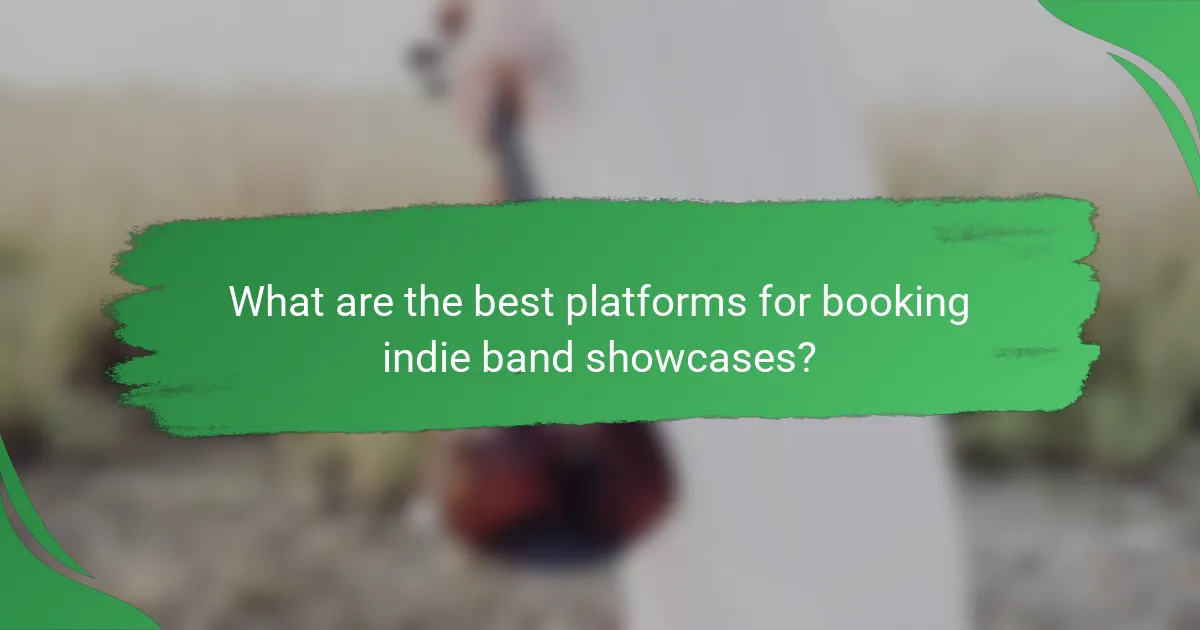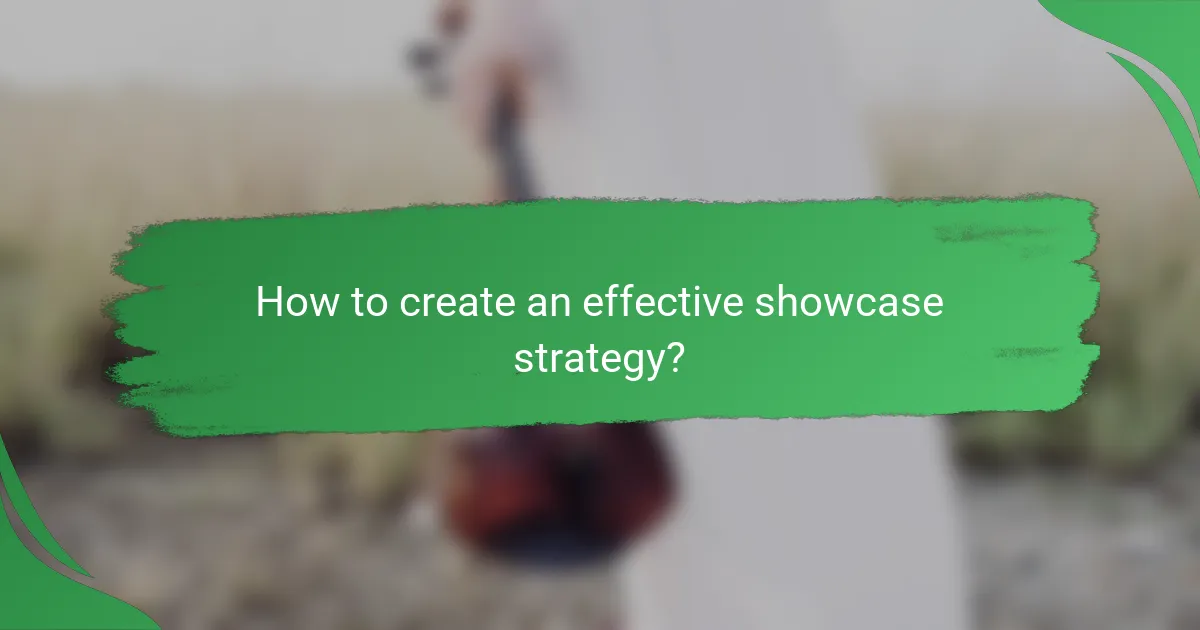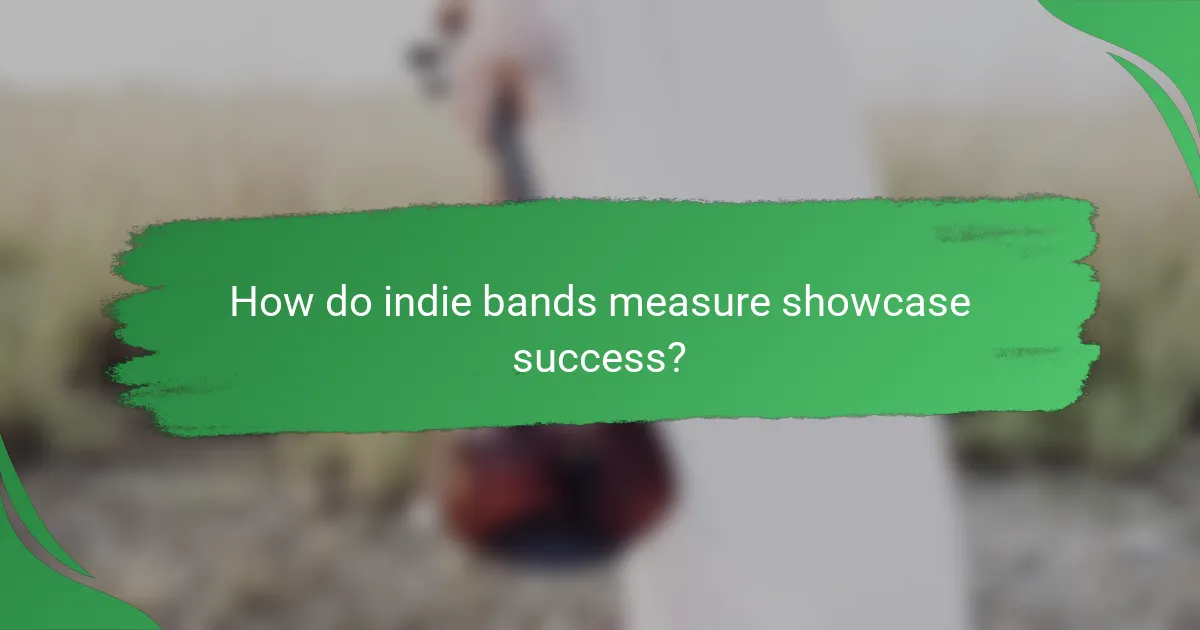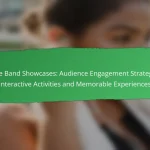In the competitive landscape of indie music, staying ahead of industry trends is crucial for successful band showcases. By leveraging social media platforms and specialized booking services, indie bands can effectively engage with fans and expand their reach. A strategic approach that includes clear objectives and audience understanding can significantly enhance visibility and performance outcomes.

How can indie bands leverage social media for showcases?
Indie bands can effectively use social media to enhance their showcases by engaging with fans, promoting events, and creating shareable content. Platforms like Instagram, TikTok, and Facebook provide unique tools to connect with audiences and generate buzz around performances.
Utilizing Instagram for audience engagement
Instagram is a powerful platform for indie bands to engage their audience through visually appealing content. Bands can post behind-the-scenes footage, rehearsal clips, and live performance snippets to create a personal connection with fans. Regularly updating stories and utilizing features like polls or Q&A sessions can further boost interaction.
To maximize reach, bands should use relevant hashtags and tag local venues or other artists. Collaborating with influencers or local music bloggers can also help expand their audience base.
Creating TikTok challenges to promote music
Creating TikTok challenges is an innovative way for indie bands to promote their music and engage with a younger audience. By encouraging fans to participate in a dance or creative challenge using a specific song, bands can increase visibility and virality. Simple and catchy hooks tend to work best for this format.
To launch a successful challenge, bands should provide clear instructions and incentives, such as featuring the best submissions on their own social media or offering merchandise. Engaging with participants by liking and commenting on their videos can foster a sense of community.
Using Facebook Events for local showcases
Facebook Events is an effective tool for indie bands to organize and promote local showcases. By creating an event page, bands can share details like date, time, location, and ticket information, making it easy for fans to RSVP. This feature also allows bands to reach a wider audience through event sharing.
To enhance attendance, bands should regularly update the event page with engaging content, such as teaser videos or reminders as the date approaches. Encouraging attendees to invite friends can further increase visibility and turnout at the event.

What are the best platforms for booking indie band showcases?
The best platforms for booking indie band showcases include Bandsintown and Sonicbids, which cater specifically to independent artists. These platforms offer tools for promotion, connecting with venues, and finding gig opportunities, making them essential for indie bands looking to expand their reach.
Using Bandsintown for concert promotion
Bandsintown is a powerful tool for indie bands to promote their concerts and engage with fans. By creating a profile, artists can share their tour dates and receive notifications about local shows, helping to build a dedicated following.
To maximize visibility, bands should regularly update their concert listings and encourage fans to follow them on the platform. This can lead to increased attendance at shows and better engagement with the audience.
Leveraging Sonicbids for gig opportunities
Sonicbids is an effective platform for indie bands seeking gig opportunities, allowing artists to submit electronic press kits (EPKs) to venues and festivals. This streamlined process simplifies the application for shows and increases the chances of being selected.
When using Sonicbids, bands should ensure their EPK is polished and includes high-quality audio samples, professional photos, and a compelling bio. Regularly checking for new opportunities and applying promptly can significantly enhance a band’s chances of landing gigs.

How to create an effective showcase strategy?
Creating an effective showcase strategy involves defining your objectives, understanding your audience, and selecting the right venues. A well-planned approach can enhance visibility and engagement, ultimately leading to greater success for your indie band.
Setting clear goals for audience reach
Establishing clear goals for audience reach is crucial for a successful showcase. Consider what you want to achieve, whether it’s increasing fan engagement, selling merchandise, or attracting industry attention. Aim for specific, measurable targets, such as reaching a certain number of attendees or gaining a specific percentage of social media followers.
Break down your goals into short-term and long-term objectives. For example, a short-term goal might be to attract 100 attendees to your next show, while a long-term goal could be to build a mailing list of 1,000 fans over the next year. Regularly assess your progress to stay on track.
Choosing the right venues for target demographics
Selecting the right venues is essential for connecting with your target demographics. Research locations that align with your band’s style and the audience you want to attract. For instance, if your music appeals to a younger crowd, consider smaller, trendy clubs or outdoor festivals popular among that age group.
Evaluate venue capacity, location, and accessibility. A venue that holds 200 people may be ideal for an intimate showcase, while larger spaces might be better for attracting a broader audience. Additionally, consider the venue’s reputation and past events to ensure it aligns with your brand.

What trends are shaping the indie music scene in 2023?
In 2023, the indie music scene is significantly influenced by the rise of virtual showcases and live streaming, as well as increased collaboration among artists. These trends are reshaping how indie bands connect with audiences and each other, creating new opportunities for exposure and creativity.
Rise of virtual showcases and live streaming
The popularity of virtual showcases and live streaming has surged, allowing indie bands to reach wider audiences without geographical limitations. Platforms like Twitch, YouTube, and Instagram Live enable artists to perform live from anywhere, often attracting viewers who may not attend traditional concerts.
To effectively utilize these platforms, bands should invest in quality audio and video equipment, ensuring a professional presentation. Engaging with the audience through chat and social media during performances can enhance the experience and foster a loyal fan base.
Increased collaboration between artists
Collaboration among indie artists is becoming more common, driven by the desire to blend genres and expand creative horizons. This trend not only enriches the music but also helps artists tap into each other’s fan bases, increasing visibility and reach.
Indie bands can explore partnerships through co-writing sessions, joint performances, or even shared promotional efforts. Utilizing online collaboration tools can streamline the process, making it easier to create and share music regardless of physical location.

How do indie bands measure showcase success?
Indie bands measure showcase success primarily through ticket sales, attendance figures, and audience feedback. These metrics provide insights into the band’s popularity, market reach, and the overall impact of their performances.
Analyzing ticket sales and attendance
Ticket sales and attendance are fundamental indicators of a showcase’s success. A strong turnout, typically in the hundreds for smaller venues, suggests that the band has effectively engaged its audience and generated interest. Tracking sales trends over time can reveal patterns, such as peak performance times or the effectiveness of marketing strategies.
To assess ticket sales, bands should compare the number of tickets sold against the venue’s capacity. A sell-out show indicates high demand, while low sales may highlight areas for improvement, such as promotional efforts or venue selection. Additionally, consider the price point; pricing tickets too high can deter attendance, while too low may undervalue the performance.
Collecting audience feedback through surveys
Gathering audience feedback through surveys is crucial for understanding the audience’s experience and preferences. Post-show surveys can provide valuable insights into what attendees enjoyed, what could be improved, and how they discovered the event. Aim for a response rate of at least 20-30% to ensure the feedback is representative.
Surveys can include questions about the performance quality, venue atmosphere, and overall satisfaction. Offering incentives, such as a chance to win free merchandise or tickets to future shows, can increase participation. Analyzing this feedback helps bands tailor future showcases to better meet audience expectations and enhance their appeal.

What are the key factors for successful indie band showcases?
Successful indie band showcases hinge on effective marketing, strong networking, and creating memorable experiences for attendees. These elements help attract audiences, build relationships, and enhance the overall appeal of the event.
Effective marketing strategies
To promote an indie band showcase, leverage social media platforms, local event listings, and email newsletters. Utilize visually appealing graphics and engaging content to capture attention and encourage sharing among potential attendees.
Consider running targeted ads on platforms like Facebook and Instagram, focusing on local music fans. Offering early bird ticket discounts or exclusive merchandise can also incentivize ticket sales and boost attendance.
Strong networking with local influencers
Building relationships with local influencers, such as music bloggers, radio hosts, and venue owners, can significantly enhance the visibility of your showcase. Invite them to attend your events and engage with them on social media to foster connections.
Collaborate with these influencers for promotional opportunities, such as interviews or guest appearances. Their endorsement can help attract a larger audience and lend credibility to your showcase, making it more appealing to potential attendees.

How can indie bands adapt to changing audience preferences?
Indie bands can adapt to changing audience preferences by staying attuned to musical trends and actively engaging with their fan base. This involves incorporating various music genres and creating interactive experiences that resonate with listeners.
Incorporating diverse music genres
To appeal to a broader audience, indie bands should consider blending different music genres into their sound. This can involve experimenting with elements from pop, rock, electronic, or even world music, which can attract fans from various backgrounds.
For example, a band that typically plays folk music might introduce electronic beats or hip-hop rhythms. This fusion can create a unique sound that stands out in a crowded market, potentially increasing their fan base.
Engaging with fans through interactive experiences
Creating interactive experiences is essential for indie bands to connect with their audience. This can include live-streaming concerts, hosting Q&A sessions, or organizing meet-and-greet events, allowing fans to feel more involved in the band’s journey.
Additionally, utilizing social media platforms for polls or feedback on new music can help bands understand their audience’s preferences. Engaging fans in this way fosters a sense of community and loyalty, which is crucial for long-term success.


